#limestone and dolomite
Explore tagged Tumblr posts
Text
Science Saturday: How to make Limestone
Limestone is a type of sedimentary rock made by chemical processes (dare I say, a chemical sedimentary rock) rather than physical processes (what we call a clastic sedimentary rock).
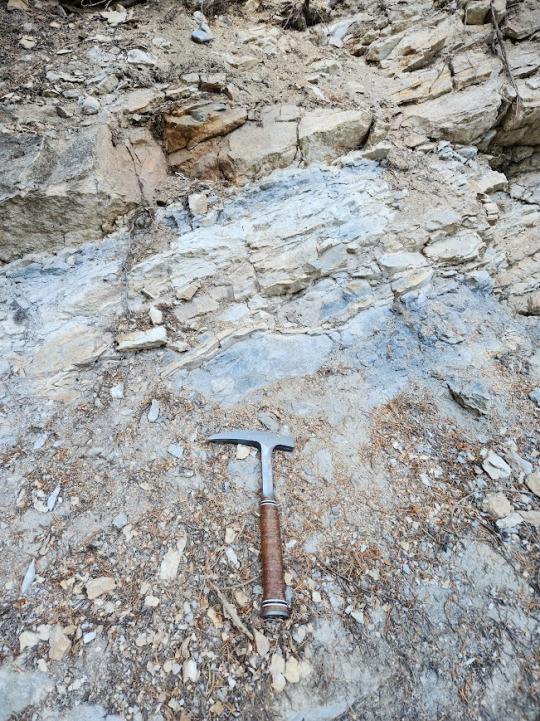
Limestone in Big Cottonwood Canyon, Utah with my hammer for scale.
Limestone is primarily composed of the mineral calcite or aragonite which precipitate out of water containing dissolved calcium ions.
(CaCO3) Calcite and aragonite chemical formula
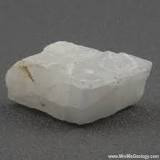
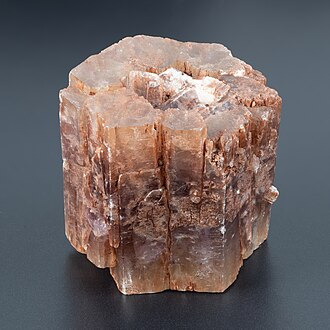
This can happen through both biologic and non-biologic processes. About 20-25% of all sedimentary rocks are carbonates and most of those carbonates are limestone. The remaining carbonates are mostly dolomite (or dolostone to avoid confusion with the mineral dolomite) which differs from limestone due to it's high magnesium content.
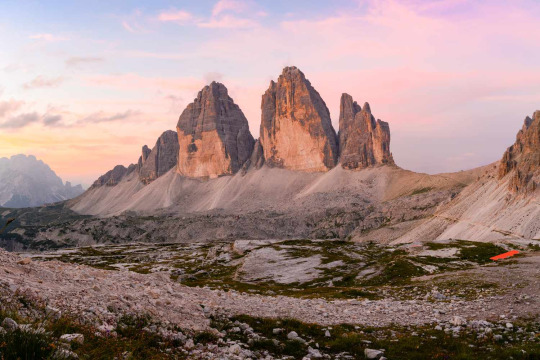
Dolomite Peaks, Italy
In fact, physically, you can't tell dolomite and limestone apart (at least not to my knowledge, I work in clastic sedimentary rocks so if you're reading this and you work in carbonates, feel free to chip in), usually just lump all carbonates I see as limestone. Technically, there are few things you can test physically but you absolutely need the right tools. Dolomite is slightly harder than limestone and does not as readily dissolve in HCl (fizzes less). Sometimes you can see a change but often they are just too similar to tell in my experience.
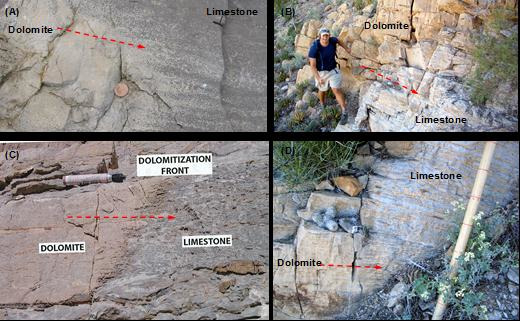
Limestone is commonly gray to white though iron or managnese can make it yellow, or red and high organic content can make it almost black.
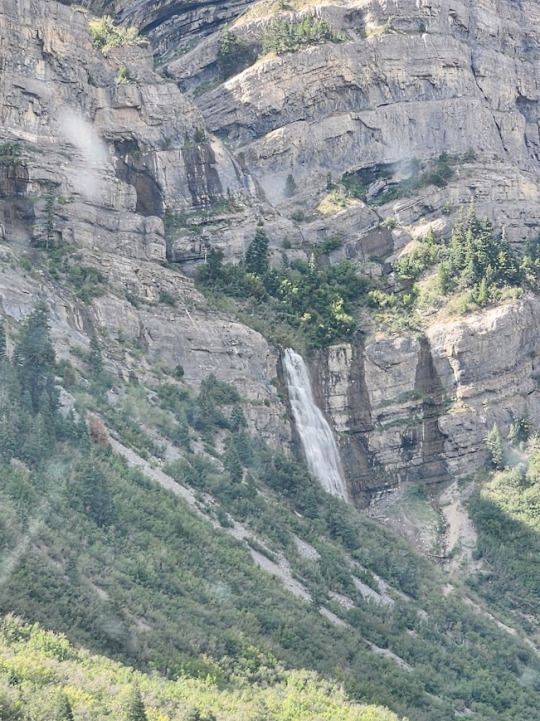
Gray limestone in Provo Canyon, Utah
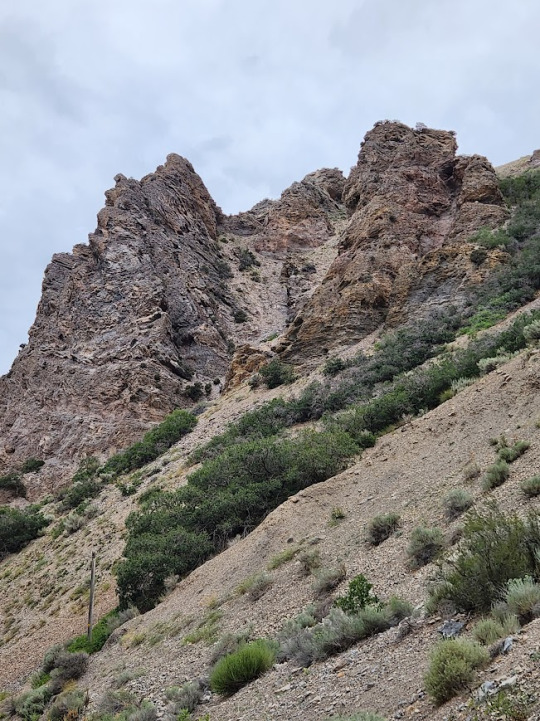
Red stained yellow limestone in Timpanogos Canyon, Utah
But how is limestone formed? One way is through biochemical processes. Many marine organisms have learned to precipitate a calcium carbonate shell. When these organisms die, they fall to the sea floor. Eventually, they are turned into bioclastic limestone with chemically precipitated calcite cement between them.
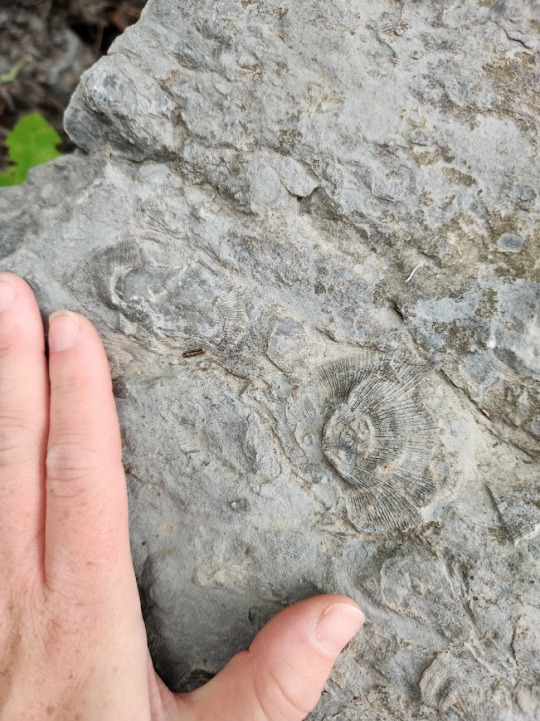
bioclastic limestone, Provo Canyon. Brachiopod shells with my hand for comparison.
One type of bioclastic limestone is finely-grained chalk like the White Cliffs of Dover which formed from coccoliths. Chalk can be formed from algae, foraminifera and plankton. It is very soft, porous version of limestone.
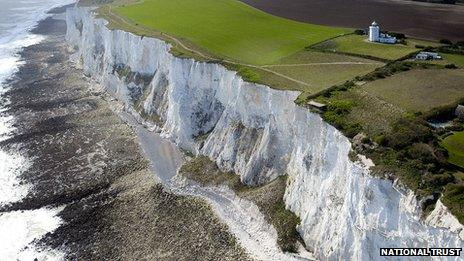
Limestone can also form chemically, precipitating straight out of the water as such: H2O + 3CO2 -> CaCO3.
And now you know the basic ways to make limestone.
96 notes
·
View notes
Text




Frank Slide, Turtle Mountain
Paleozoic, Middle Carbonate Unit
Silicate Fossils-likely crinoids
Dolomite, Chert, and Limestone
Frank Slide, Turtle Mountain
#photograph#photography#journal#record#archive#frank#Alberta#frank slide#geology#paleontology#fossils#paleozoic#chert#dolomite#limestone#turtle mountain#geography#rocks#crinoid
20 notes
·
View notes
Text
The Importance of Quality Assurance in Limestone Procurement | Trusted Suppliers

Limestone is an indispensable raw material in numerous industries, from construction and steel manufacturing to agriculture and environmental remediation. Ensuring the quality of limestone is critical for achieving optimal results in these applications. The Importance of Quality Assurance in Limestone Procurement cannot be overstated, as it directly impacts the efficiency, safety, and cost-effectiveness of various processes.
In this article, we will explore why quality assurance is essential in limestone procurement and how trusted suppliers like Indian lime manufacturers and limestone suppliers in Rajasthan maintain high standards to deliver reliable products. Additionally, we’ll delve into the benefits of choosing the best dolomite lime products in Jodhpur for specific applications.
1. Understanding Quality Assurance in Limestone Procurement
Quality assurance involves a systematic approach to verifying that the limestone meets predefined specifications and industry standards. This process ensures:
Consistency in chemical composition
Appropriate physical properties
Adherence to environmental and safety regulations
By implementing robust quality assurance measures, suppliers can deliver products that fulfill customer requirements and minimize potential risks associated with substandard materials.
2. Why Quality Assurance Matters
a. Optimized Performance
High-quality limestone is essential for applications such as:
Producing cement and concrete
Flue gas desulfurization
Soil stabilization
Industrial flotation processes
Materials sourced from reputed Indian lime manufacturers ensure consistent performance in these critical applications.
b. Compliance with Standards
Quality assurance helps ensure that the limestone complies with:
Industry-specific standards
Government regulations
Environmental guidelines
For instance, limestone suppliers in Rajasthan adhere to strict protocols to maintain compliance, ensuring their products are safe and effective.
c. Cost Efficiency
Substandard limestone can lead to:
Equipment damage
Reduced efficiency
Increased maintenance costs
Investing in quality-assured materials from trusted sources like Indian lime manufacturers helps avoid these issues and reduces overall costs.
3. Key Factors in Quality Assurance
a. Chemical Composition
The primary component of high-grade limestone is calcium carbonate (CaCO3). Quality assurance tests ensure minimal impurities like silica, alumina, and magnesium.
b. Physical Properties
Physical characteristics such as hardness, porosity, and grain size are critical for different applications. For example, the best dolomite lime products in Jodhpur are known for their optimal physical properties, making them ideal for construction and industrial uses.
c. Consistency
Consistency in quality across batches is vital to ensure reliability and performance. Leading limestone suppliers in Rajasthan utilize advanced technologies to maintain uniformity in their products.
4. The Role of Indian Lime Manufacturers in Quality Assurance
Indian lime manufacturers play a crucial role in maintaining quality assurance through:
a. Advanced Testing Facilities
Top manufacturers invest in state-of-the-art laboratories to test the chemical and physical properties of limestone. These facilities ensure products meet stringent quality standards.
b. Sustainable Mining Practices
To maintain long-term quality, responsible limestone suppliers in Rajasthan focus on sustainable mining practices. This approach preserves the natural characteristics of limestone deposits while minimizing environmental impact.
c. Certifications and Compliance
Reputed manufacturers often hold certifications such as ISO 9001 for quality management, ensuring their processes align with global standards.
5. Choosing the Best Dolomite Lime Products in Jodhpur
Dolomite lime, a variant of limestone containing magnesium, is widely used in:
Agriculture (to neutralize soil acidity)
Construction (as a filler material)
Steel manufacturing (as a fluxing agent)
When sourcing the best dolomite lime products in Jodhpur, consider the following:
Purity levels
Availability in desired quantities
Adherence to industry standards
Jodhpur’s dolomite lime is renowned for its superior quality, making it a preferred choice for various industrial and agricultural applications.
6. Benefits of Working with Limestone Suppliers in Rajasthan
Rajasthan is a hub for high-quality limestone production, offering several advantages:
a. Rich Deposits
The state boasts abundant limestone reserves with high calcium carbonate content, ensuring premium quality.
b. Experienced Suppliers
Limestone suppliers in Rajasthan have decades of experience, enabling them to cater to diverse industry requirements.
c. Customization Options
Leading suppliers provide customized solutions, such as tailored packaging and specific grades of limestone, to meet unique client needs.
d. Reliable Logistics
Proximity to major industrial hubs and robust transportation networks ensure timely delivery of products across India and beyond.
7. How to Assess Limestone Quality Before Procurement
To ensure you’re sourcing high-quality limestone, follow these steps:
a. Request Samples
Ask for samples to test the limestone’s suitability for your application. Trusted suppliers like Indian lime manufacturers readily provide samples for evaluation.
b. Review Certifications
Check for certifications that validate the supplier’s commitment to quality.
c. Visit Facilities
If possible, visit the supplier’s mining and processing facilities to verify their quality assurance practices.
d. Compare Suppliers
Evaluate multiple limestone suppliers in Rajasthan based on price, quality, and customer service to make an informed decision.
8. The Long-term Impact of Quality Assurance
Investing in quality-assured limestone yields numerous long-term benefits, such as:
Enhanced operational efficiency
Reduced downtime and maintenance costs
Improved safety and compliance
Businesses that prioritize quality assurance in limestone procurement gain a competitive edge and build trust with their stakeholders.
Conclusion
The Importance of Quality Assurance in Limestone Procurement cannot be overlooked. By partnering with reputable Indian lime manufacturers, sourcing the best dolomite lime products in Jodhpur, and working with reliable limestone suppliers in Rajasthan, businesses can ensure consistent quality and performance in their operations.
With robust quality assurance measures in place, you can achieve better outcomes, reduce risks, and contribute to sustainable practices in your industry
0 notes
Text
somehow im JUST realizing my caves might not be plausible. fuck my entire life
#i have them in and around the rift valley#the rock there would be igneous. basalt most likely MAYBE andesite or ryolite on account of the location#caves... dont form in igneous rock. they form in sedimentary#stuff that dissolves. limestone and dolomite#my fuckign....#ill have to do some more looking into how rift valleys work exactly. what kinds of geology exist not just IN it but AROUND it#i MAY be able to still make it work. but like. what hte hell
0 notes
Text

Welcome back to Trilobite Tuesday! Pictured is a rare Bumastus graftonensis from the tan-toned Niagaran Limestone outcrops surrounding the Joliet Formation. This locale, near the small Midwestern town of Grafton, Illinois, is known for its three-dimensionally preserved trilobites. In certain Silurian locations, trilobites, like this one, emerge from their eons-old sedimentary encasements as little more than dull, dolomite-infused internal molds—specimens totally devoid of their calcite carapaces.
#science#amnh#museum#nature#fossil#natural history#animals#fact of the day#did you know#trilobite#trilobite tuesday#cool animals#silurian
471 notes
·
View notes
Text







Hymenelia coerulea
I love finally learning the name of lichen I have seen a bunch of times but never knew anything about. And considering that H. coerulea is blue, a very rare color in the world of lichens, I know I have seen this guy before on my forays into the Alps. This crustose lichen has a thin, largely endosubstratic thallus that appears pale blue-gray when dry, and more true-blue when wet. It has deeply immersed apothecia which have a blue-gray to black discs sunken into the calciferous substrate. It grows on inclined dolomite and limestone at high elevation in Europe, though it may have a wider range that has yet to be fully elucidated. H. coerulea has an Asterochloris green-algal photobiont.
images and info: source
#lichen#lichens#lichenology#lichenologist#mycology#ecology#biology#fungi#fungus#trypo#trypophobia#Hymenelia coerulea#Hymenelia#I'm lichen it#lichen a day#daily lichen post#lichen subscribe#nature#the natural world#natural science#environmental science#life science#beautiful nature#weird nature#symbiosis#symbiotic organisms#algae
315 notes
·
View notes
Text
Dolomites, Italy: The Dolomites, also known as the Dolomite Mountains, Dolomite Alps or Dolomitic Alps, are a mountain range in northeastern Italy. They form part of the Southern Limestone Alps and extend from the River Adige in the west to the Piave Valley in the east. Wikipedia
242 notes
·
View notes
Text
Paleo-caves in Death Valley
You have probably heard of "caves", or a natural void formed in rock. Caves are formed in a number of ways, but the most familiar are probably those formed in limestone - called karst or karstic. Karst caves are formed by the steady dissolving of limestone rock by naturally acidic groundwater percolating through the ground, often along faults or other natural weak areas.
Death Valley in California is not a hotbed of limestone caves, though evidence of them can be seen in a number of places! Ancient caves, often tens or hundreds of millions of years old, sometimes collapse or fill in with silt/minerals/debris. An ancient cave formation is called "paleokarst", and there are a few areas in Death Valley where you can find it. The easiest to access is in Titus Canyon, a major canyon who's lowest reach carves its way through limestone bedrock, leaving behind towering polished rock walls and revealing the internal structure of the rock.

Titus Canyon's narrow section is carved through the Bonanza King Formation, a Cambrian-age (538 - 485 million years ago) marine sedimentary rock package several kilometers thick. It's found in many areas of Death Valley and the surrounding region. Across its area and thickness, it alternates from dolomite to limestone (dolomite minerals versus calcite minerals). Dolomite doesn't usually dissolve and form caves, but limestone does - and the many fractures in this rock appear to have allowed numerous tiny caves to form somewhere in the distant past. Most of these have since been filled in with calcite minerals, making them paleokarst.

In this image, you can see the void of the cave lined with thinly-layered calcite. It has a flat floor, and these features are characteristic of having formed in a cave. In Titus Canyon, we can find these from a few inches to a few meters across, and as the canyon has been carved into the rock, these voids are exposed. This one below tells an exceptionally clear story:

You don't need to be a geologist to see how this differs from the first example. There's a weird pendant-shaped protrusion hanging from the top, there are layers in the minerals, the bottom half is red… there's a lot going on. Let's get some lines on there and figure out what we can see:

That's better. OK - I've separated out the parts of this outcrop which from my desk look to be distinct. Here's a close-up of part of the left-center area to show how it appears different up close.

OK, so we have the blue-gray limestone bedrock on the right, top, and lower left, then a gray-red area with layers and what looks like gravel or other angular pieces of the limestone. Above that is a finely-layered calcite deposit (remember? that's cave-like!), and above that is a layer of calcite which is rather porous. The top surface of this area is sort of scalloped and curved, which is also characteristic of limestone caves.

Here's the fully interpreted version. Let's go through the sequence of events. First, we have the limestone bedrock of the Bonanza King Formation (BKL). At some time in the distant past, a portion of it dissolved away and formed a cave. Over time, silt and debris filled in the bottom of this cave. Because it is ancient, we call it paleo-fill (OPF). This might have happened at a time when the cave was dry (not containing water), since if it was wet we would expect some amount of calcite to be deposited around its perimeter as is typical in limestone caves.
Above that is a layer of thinly-layered calcite, the cave mineral. This layer contains some reddish silt and the occasional fragment of the limestone, so the cave was probably happily active during the time that was deposited! This is the oldest cave mineralization phase I can discern in this outcrop, so I call it Old Cave Calcite (OCC).
Next, we have a slightly porous, light-colored calcite deposit. The porosity suggests to me that it was deposited faster, but I am not an expert on cave deposits so will not comment further. This unit fills the cave to its top in most places! I call this the Middle-age cave calcite (MAC).
Finally, the youngest unit is another cave-deposited calcite (YCC). As in the first cave picture above, it is a coarser-grained pale yellow color with layers that parallel the sides of the void. Most of the paleo-caves you can find in Titus Canyon are filled with this sort of calcite, and it may be geologically recent (last million years?). It filled the final remnant of this ancient paleo-cave, and is contrasting with the material around it. This visual and textural contrast is what inspired me to write this post in the first place - the best example I've seen in person of paleo-karst and the evolution of a miniature cave system, right in the heart of Death Valley - my favorite place in the world.
#geology#photography#adventures#bettergeology#california#rocks#death valley#death valley national park#cave#paleokarst#limestone#california geology#geologia#i love rocks
95 notes
·
View notes
Text
Geology and The Terror
As a geologist who is incapable of turning off their geology brain even while watching shows for fun, one of the things that baffles me a bit about The Terror is why they continuously refer to the landscape as shale when both King William Island and the filming location in Pag, Croatia are dominated by limestone. Given the desolation of the landscape, the geology is rather at the forefront of many scenes so it was fun to try and parse it out as I watched.
King William Island, Nunavut, Canada
According to the official map of the bedrock of the region as published by the Canadian government (Harrison et al., 2015), the entirety of King William Island is mapped as dolostone, dolomitic limestone, and limestone with only minor components of shale, sandstone, conglomerate, and breccia. This is a shelf marine deposit dating back to the Late Cambrian, so this is very old sedimentary rock but younger than most of the surrounding hard rock that composes various parts of the Canadian shield. Notably, the pink units mapped on the Boothia Peninsula are Paleoproterozoic in age (2.5-1.6 billion years old), potentially up to 2 billion years older than the limestones of King William Island.

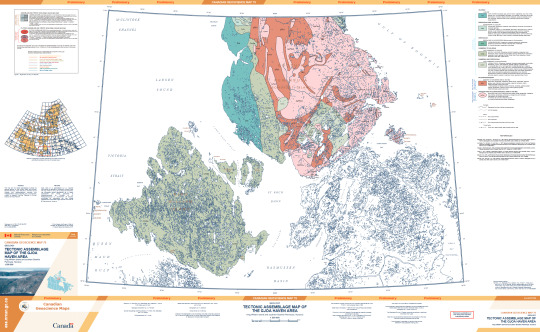
(This is an absolutely massive .pdf file with some scaled features so I would recommend viewing via the official publication to actually read anything or see fine details: publications.gc.ca/pub?id=9.557274&sl=0)
Notably, this map was published in 2015, 8 years after the novel was written. However, according to the bibliography for the map (which can be accessed via the previous link) a preliminary geologic map has existed for the area since at least 1967, though I was unable to track this publication down online. The novel was clearly thoroughly researched and Dan Simmons could have easily accessed this publication and others through multiple institutions.
The surficial geology of King William Island has also been mapped, and is predominantly glacial, as one would expect given it's location. For those unfamiliar with glacial geology processes, this is basically saying that the bedrock is buried under a bunch of glacial deposits. Glacial till is composed of rocks and sediments plucked from the bedrock and ground up. This is why the surface of the island is not one big rock, but a bunch of smaller pieces. Interestingly, the material on the southern part of the island is sandier because it contains more material derived from the Canadian Shield further south. If you're interested in glacial geology, I highly recommend zooming around a bit on Google Earth because the features here are GORGEOUS.
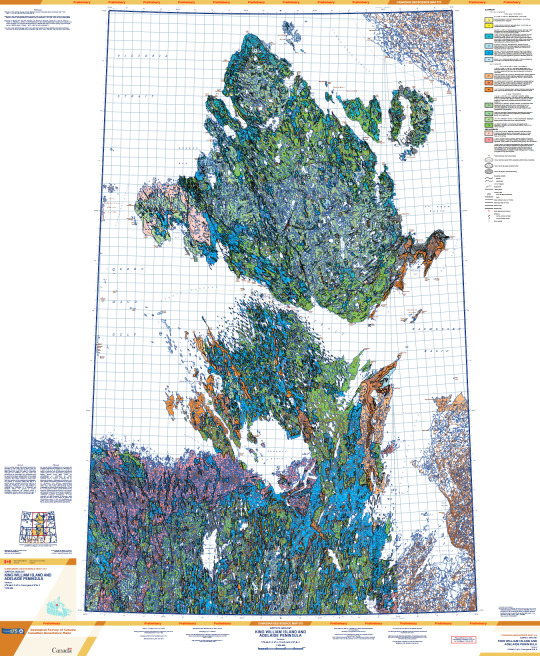
(This map is absolutely massive and the lines scale with zoom so it's hard to see at this resolution, access it here: publications.gc.ca/pub?id=9.834073&sl=0)
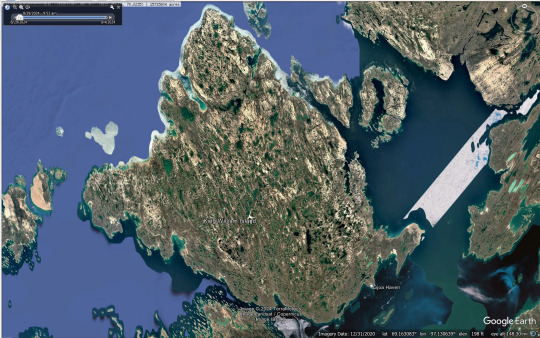
(Google Earth Pro, satellite imagery from 2020)
According to the surface geology map and Google Earth, the actual landscape of King William Island is much more water logged than it appears in the show. It's not entirely impossible that there has been some geomorphological change since 1848, but most of the features mapped would have been formed during the last ice age and as the glaciers melted and not more recently. This would have been handy for the men of the Franklin Expedition because each of these pools is filled with freshwater.
Pag, Croatia
Tracking down a geologic map of Croatia was somewhat challenging as I don't speak Croatian. I was able to find a map of the whole country, and while it's all in Croatian the symbol for the geologic time periods is universal so time periods can be correlated. This shows that the units that make up Pag are Cretaceous and Paleocene-Eocene in age.

(Map accessed here: https://www.hgi-cgs.hr/en/geoloska-karta-republike-hrvatske-1300-000/)
I was able to find a .pdf (access here: http://kig.kartografija.hr/index.php/kig/article/view/158/274) that had a bit more information on the map above but at a lower resolution. This states that the Cretaceous units are dominantly carbonates from the Adriatic sea and the Eocene units are also carbonates. This makes sense as both the Cretaceous and Paleocene-Eocene boundary/PETM are times of increased global temperature correlated with increases in global sea level.
As always, the best geology website out there, Macrostrat, also came through on the unit lithologies. I was unable to access the source listed on Macrostrat, but both the Cretaceous (green) and Paleocene-Eocene units (orange) are listed as limestone.
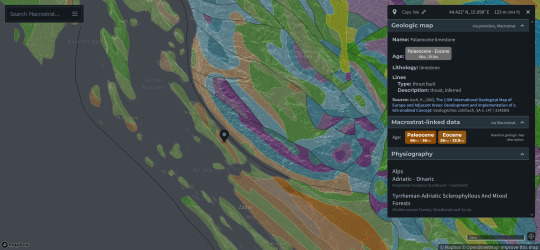
(Source: https://macrostrat.org/map/#x=16&y=23&z=2)
One of the best views that we get of the geology on Pag is the last scene with Bridgens in episode 9. During the zoom out of this scene we get a really nice view of the bedrock and debris covering it.

Given all of this, I'm really not sure where the landscape description as shale came from. If there is historical precedence for calling the rocks on the island shale, let me know! I have read a few books but none of the primary sources from the expeditions to this region, so if it comes from that I wouldn't be surprised.
Overall though, I have to say that the filming location was well chosen given the similarities it holds to the geology of King William Island.
#the terror#i have no idea whether this is of interest to anybody else#but i haven't been able to stop thinking about it since i started the show#because obviously the first thing i did was open up macrostrat to see what the geology was like#geology#peter posts#fr though the scene with bridgens is top tier in terms of getting a good view of the geology#it only took me three watches of the show to cave and make a post about it#franklin expedition
135 notes
·
View notes
Note
top five rocks
5. 4. 3. Andesite, Anorthosite, Aplite, Basalt, Basanite, Carbonatite, Dacite, Diabase, Diorite, Dunite, Foyaite, Gabbro, Granite, Granodiorite, Harzburgite, Hawaiite, Hornblendite, Ignimbrite, Ijolite, Kimberlite, Komatiite, Limburgite, Monzonite, Nepheline syenite, Norite, Obsidian, Pegmatite, Peridotite, Phonolite, Picrite, Porphyry, Pumice, Pyroxenite, Rapakivi, Rhomb-porphyry, Rhyolite, Scoria, Sövite, Syenite, Tephrite, Tonalite, Trachyandesite, Trachyte, Troctolite, Trondhjemite, Tuff, Arkose, Banded iron formation, Bauxite, Bog iron, Breccia, Chalk, Chert, Coal, Conglomerate, Coquina, Diamictite, Diatomite, Dolomite, Evaporite, Flint, Graywacke, Gypsum, Laterite, Lignite, Limestone, Oil shale, Oolite, Phosphorite, Sandstone, Shale, Siltstone, Tillite, Travertine, Turbidite, Umber, Amphibolite, Anthracite, Blueschist, Charnockite, Eclogite, Epidosite, Fenite, Gneiss, Granulite, Greenschist, Greisen, Hornfels, Marble, Metapelite, Migmatite, Mylonite, Phyllite, Quartzite, Schist, Serpentinite, Shungite, Skarn, Slate, Soapstone, Suevite 2. Lapis Lazuli 1. Cummingtonite
25 notes
·
View notes
Note
We eat and lick rocks on purpose everyday already, they're called salt crystals
Indeed! Humans additionally consume components of chalk, limestone, and dolomite… amongst other minerals.
#arcane viktor#viktor lol#arcane rp#arcane roleplay#viktor league of legends#arcane#arcane lol#viktor arcane#ask viktor#viktor#viktor rp#viktor roleplay#arcane league of legends#viktor arcane rp#arcane rp blog#arcane ask blog#askviktor
23 notes
·
View notes
Text




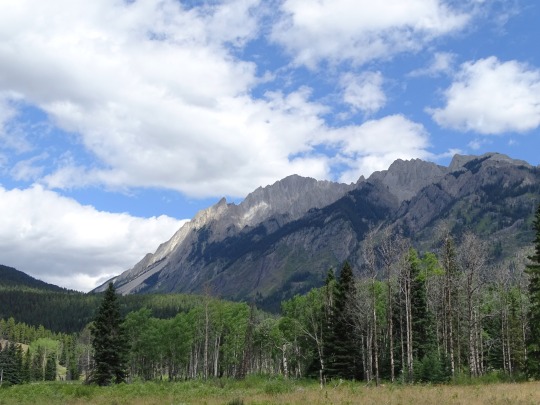




Banff National Park, AB (No. 5)
The Canadian Rockies may have risen up to 8,000 metres (26,000 ft) approximately 70 m.y.a. Once mountain formation ceased, erosion carved the mountains into their present rugged shape. The erosion was first due to water, then was greatly accelerated by the Quaternary glaciation 2.5 million years ago. Glacial landforms dominate Banff's geomorphology, with examples of all classic glacial forms, including cirques, arêtes, hanging valleys, moraines, and U-shaped valleys. The pre-existing structure left over from mountain-building strongly guided glacial erosion: mountains in Banff include complex, irregular, anticlinal, synclinal, castellate, dogtooth, and sawback mountains.
Many of the mountain ranges trend northwest to southeast, with sedimentary layering dipping down to the west at 40–60 degrees. This leads to dip slope landforms, with generally steeper east and north faces, and trellis drainage, where rivers and old glacial valleys followed the weaker layers in the rocks as they were relatively easily weathered and eroded. Classic examples are found at the Banff townsite proper: Mount Rundle is a classic dip slope mountain. Just to the north of the Banff townsite, Castle Mountain is composed of numerous Cambrian age rock formations. The uppermost section of the peak consists of relatively harder dolomite from the Eldon Formation. Below that lies the less dense shales of the Stephen Formation and the lowest exposed cliffs are limestones of the Cathedral Formation. Dogtooth mountains, such as Mount Louis, exhibit sharp, jagged slopes. The Sawback Range, which consists of nearly vertical dipping sedimentary layers, has been eroded by cross gullies. The erosion of these almost vertical layers of rock strata in the Sawback Range has resulted in formations that appear like the teeth on a saw blade. Erosion and deposition of higher elevation rock layers has resulted in scree deposits at the lowest elevations of many of the mountains.
Source: Wikipedia
#Bow Valley Parkway#aspen#travel#original photography#vacation#tourist attraction#landmark#landscape#countryside#Rocky Mountains#Canada#summer 2024#Alberta's Rockies#Canadian Rockies#flora#nature#forest#sub-alpine fir#Alberta#Banff National Park#Bow River#pine#tree#woods#Hillsdale Meadow#Mount Ishbel#Mount Cockscomb#Mount Cory
20 notes
·
View notes
Note
So idk if you've seen the hunger games but I was watching it on my Alexa and I was wondering if you could do Nick di Angelo x male reader w/ that part in the first hunger games where katniss is in the cave with peeta when his leg is ingured(it's fine if you csnt)
Of course I can do that! I'm not gonna lie I haven't seen the movie in a long time so I did have to like, watch the clip again just to get a feel for it so I hope that it turns out relatively well 😭

The elephant in the...cave?

Nico Di Angelo x Male! Reader
Pronouns: second person, implied male
Word count: 757
Tw: Blood, graphic description of wound, general Greek mythology things

You and Nico were sent on what seemed to be a normal mission by the camp, something quick and easy with a simple objective. But of course, you're both half bloods, so nothing can be that easy.
You weren't expecting to run into Lamia, or even expecting to run into any monsters. You just needed to bring a simple package to whomever and get back to camp, but obviously, she wasn't going to let that happen.
The battle itself wasn't exactly memorable. You went in with your weapon, Nico behind you begging you to let him handle it, and next thing you knew, everything was black. The next time you woke up you were laying on the grass, blood staining several clovers and dandelions. You glanced around, seeing Nico panting, hands on his knees with his sword out. The next thing you noticed was the abundance of dust. He killed her, you thought, he did it. And that's all you were thinking when he rushed over to you.
"(Name)! Are you okay?!" He asks, flipping you over onto your back, noticing the crimson liquid seeping from your leg. "J-just a little woozy, other than that I'm fine." You said, going to try and stand up. Obviously you fell back onto your ass. "(Name) We need to get you somewhere...anywhere else." He says, glancing around trying to find somewhere to take you. His eyes land on a nearby cave, "There, that cave should be fine." He says, hoisting you up and leaning you against him.
After about 15 minutes, you both finally make it, and he leans you against the wall of the cave, "Nothing's gonna find you in here." He says, leaning closer to you to actually see you in the dark cave "They already found me Nico, my blood is like a dinner bell ringing for them." You say, groaning slightly as you pull yourself up so you're in more of a sitting position. Now you can finally see what is wrong with your leg.
It looks more like someone took a chunk out of it, her claws having left indents in the wound, making it more uneven and textured looking. It wasn't too deep in your leg, but it was the copious amounts of blood loss that was making you feel extremely dizzy and nauseous. The entire left side of your pants were coated in blood, and your wounds was still dripping with it.
"Well, we'll just get you some medicine, I can shadow travel back to camp and I'll get you some...it...it will be okay." He says, looking back at you. You know what happened to his sister, and you know how scared he is, but you're too tired, and everything feels too heavy for you to even move. "We don't have much ambrosia right now, and even then, I think it's just...it's just too much Nico." You say, the exhaustion plaguing your face.
"We have to figure something out!" He almost shouts, the fear he's feeling now coaxing him to the side of anger. "Like what Nico, there's nothing." You say, almost angry back. He just looks back at you, tears threatening to flow from his eyes. He sits down next to you, his sword clattering on the limestone and dolomite ground. "Just, something." He says, and he looks at you again, this time there's something more with the fear and anger, it's his love. The love he has for you that's always hidden beneath all of this fear and hatred.
For a second, you can almost forget that you might die from blood loss right now, or that there's no one else who you know is coming to get you. Right now all you know is that the boy you have loved for so long is staring back at you with the same requited feelings. Before you know or even realize, his lips are on your cheek, and just as soon they are gone. When he pulls away, he looks almost just as surprised as you are that he did that.
He stands up again, pulling you up with him, but this time it feels like there's more love within his touch, something softer within his skin. "I'm going to shadow travel us back to camp, this mission is over." He says, and you don't even have the energy to argue back.
And it might have been the blood loss, but you were sure that you saw some hints of blush on his cheeks right before he shadow traveled you both away.

I really hope you enjoyed this, the amount of times I rewatched the scene though was actually a little insane, but enjoyable regardless.
Make sure to drink water and eat food
#pjo hoo toa#pjo x reader#hoo x reader#nico di angelo x reader#nico di angelo#romantic#nico di angelo x male reader#hunger games#UHM I DIDN'T MEAN FOR THIS TO GET SO DEPRESSING THATS KINDA LOWKEY MY BAD
31 notes
·
View notes
Text

Common Challenges in Limestone Processing and Their Solutions | Lime Manufacturers in Jodhpur
Limestone is a versatile natural resource with a wide range of industrial applications, from construction materials to chemical processing. However, like any resource, it comes with its own set of challenges in processing and handling. In this article, we will delve into the common challenges in limestone processing and their solutions, ensuring efficient use and better productivity. Whether you’re dealing with dolomite lime products in Jodhpur or seeking reliable limestone suppliers in Rajasthan, understanding these challenges is crucial.
Understanding Limestone Processing
Limestone processing involves extracting, crushing, and refining limestone for various applications. The complexity arises due to variations in limestone’s composition, moisture content, and intended application. Companies like Lime Manufacturers in Jodhpur play a vital role in ensuring high-quality lime products.
Common Challenges in Limestone Processing and Their Solutions
1. Variability in Limestone Composition
Limestone deposits often vary in composition, containing impurities like silica, clay, or iron. This variability affects the quality of lime products.
Solution:
Implementing rigorous quality control measures.
Utilizing advanced analytical tools to test raw materials.
Partnering with trusted limestone suppliers in Rajasthan ensures consistent quality.
2. Material Handling and Transportation Issues
Transporting limestone can be challenging due to its weight and abrasiveness. Improper handling can lead to material loss or equipment wear.
Solution:
Using heavy-duty conveyors and material handling equipment.
Adopting preventive maintenance for machinery.
Sourcing from reliable Lime Manufacturers in Jodhpur minimizes material handling concerns.
3. Moisture Content and Stickiness
High moisture content can make limestone sticky, causing blockages in equipment like crushers and conveyors.
Solution:
Pre-drying the limestone before processing.
Installing self-cleaning conveyor systems.
Choosing high-quality dolomite lime products in Jodhpur ensures better processing outcomes.
4. Dust Generation and Air Pollution
Limestone processing generates a significant amount of dust, which can pose health risks and environmental challenges.
Solution:
Installing dust collection and suppression systems.
Regularly maintaining filters and scrubbers.
Working with environmentally conscious limestone suppliers in Rajasthan helps mitigate pollution.
5. Equipment Wear and Tear
The abrasive nature of limestone can cause excessive wear and tear on processing equipment, leading to downtime and higher costs.
Solution:
Using wear-resistant materials in equipment design.
Regularly inspecting and replacing worn-out parts.
Sourcing durable lime from trusted Lime Manufacturers in Jodhpur reduces the strain on equipment.
6. Energy Consumption
Limestone processing can be energy-intensive, particularly during crushing and calcination stages.
Solution:
Implementing energy-efficient machinery and processes.
Using waste heat recovery systems.
Procuring energy-optimized dolomite lime products in Jodhpur.
7. Scaling and Fouling in Kilns
Kilns used in lime production often experience scaling, which reduces efficiency and increases maintenance costs.
Solution:
Regular cleaning and maintenance of kiln surfaces.
Using additives to minimize scaling.
Collaborating with experienced Lime Manufacturers in Jodhpur ensures smooth kiln operations.
8. Inconsistent Particle Size
Achieving consistent particle size is crucial for applications like soil stabilization or chemical processes. Variations can compromise product performance.
Solution:
Utilizing precision crushers and grinders.
Implementing sieving and screening mechanisms.
Partnering with reputed limestone suppliers in Rajasthan ensures uniform particle size.
9. Limited Availability of High-Quality Limestone
In some regions, accessing high-purity limestone is a challenge, affecting production capabilities.
Solution:
Exploring alternative sources like dolomite lime products in Jodhpur.
Investing in beneficiation techniques to improve the quality of available limestone.
Collaborating with well-established Lime Manufacturers in Jodhpur for reliable supply.
10. Environmental Regulations and Compliance
Stringent environmental regulations can affect limestone processing operations, requiring compliance with emission norms and waste disposal standards.
Solution:
Adopting eco-friendly technologies and practices.
Training employees on regulatory compliance.
Sourcing from eco-conscious limestone suppliers in Rajasthan ensures adherence to standards.
Why Rajasthan Is a Hub for Limestone Processing
Rajasthan, with its abundant limestone reserves, is a leading producer of lime products in India. Cities like Jodhpur are home to reputed Lime Manufacturers in Jodhpur who offer a range of dolomite lime products in Jodhpur. The state’s well-developed infrastructure and experienced limestone suppliers in Rajasthan make it a preferred choice for industries across the country.
Final Thoughts
Addressing the common challenges in limestone processing and their solutions is essential for optimizing production and ensuring sustainability. From sourcing high-quality raw materials to implementing advanced technologies, every step contributes to efficient processing. Whether you’re looking for dolomite lime products in Jodhpur or reliable Lime Manufacturers in Jodhpur, understanding these challenges and their solutions will empower you to make informed decisions.
By partnering with trusted limestone suppliers in Rajasthan, businesses can overcome these challenges and drive long-term growth. Ensure you collaborate with industry leaders who prioritize quality, efficiency, and environmental responsibility.
0 notes
Text

The Dolomites also known as the Dolomite Mountains, Dolomite Alps or Dolomitic Alps, are a mountain range in northeastern Italy. They form part of the Southern Limestone Alps and extend from the River Adige in the west to the Piave Valley in the east. Wikipedia
77 notes
·
View notes
Text

Statue (dolomitic limestone) of a Ptolemaic queen bearing a "Cleopatra" cartouche, perhaps representing Cleopatra VII (r. 51-30 BCE). Now in the Metropolitan Museum of Art.
#classics#tagamemnon#ancient history#Hellenistic period#Egypt#Ancient Egypt#Ptolemaic Egypt#Hellenistic Egypt#Cleopatra#Cleopatra VII#art#art history#ancient art#Egyptian art#Ancient Egyptian art#Hellenistic art#Greco-Egyptian art#Ptolemaic art#sculpture#portrait sculpture#statue#limestone#stonework#carving#cartouche#Metropolitan Museum of Art
171 notes
·
View notes